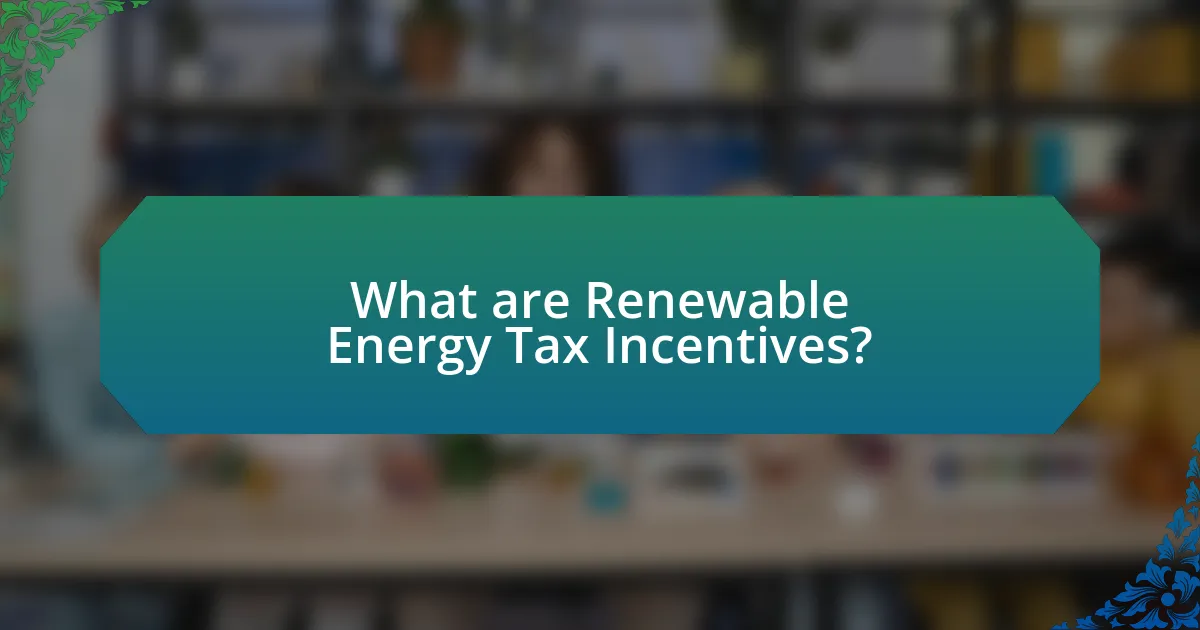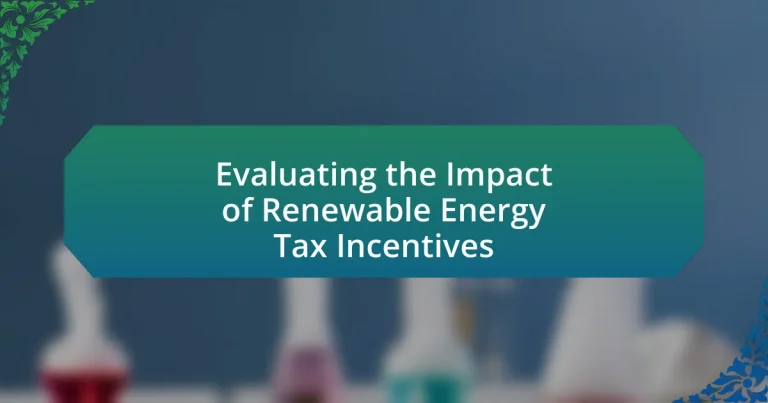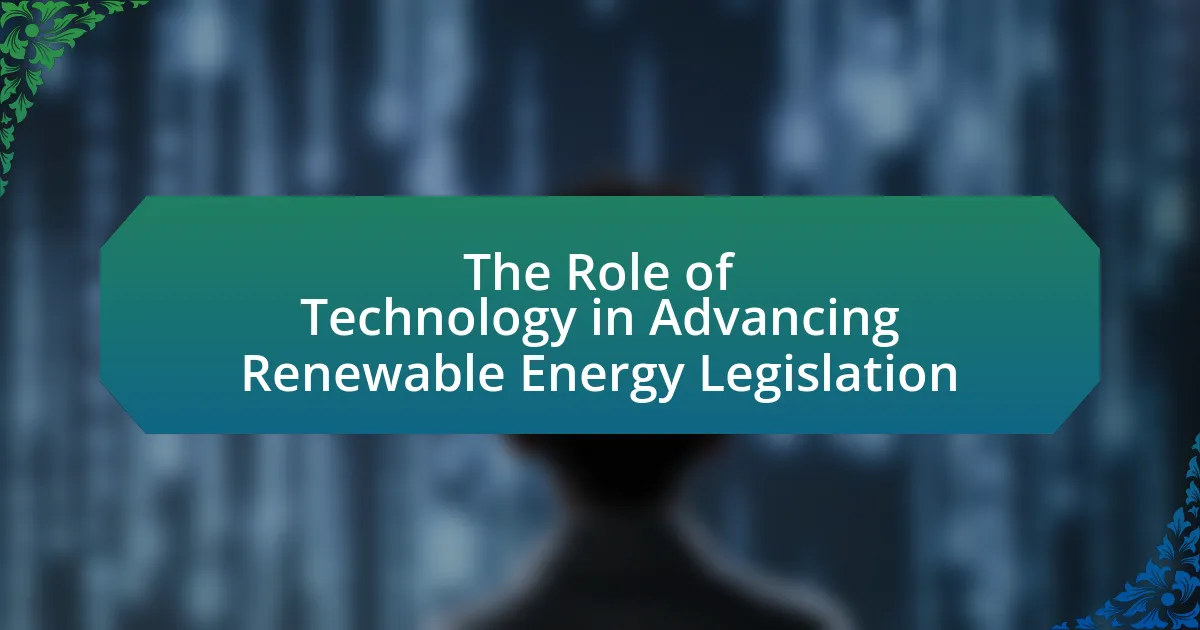Renewable Energy Tax Incentives are financial benefits provided by governments to promote the development and use of renewable energy sources, including tax credits, deductions, and grants. This article evaluates the impact of these incentives on renewable energy adoption, investment, job creation, and environmental benefits. It discusses various types of tax incentives available, their regional variations, and their economic implications, including effects on government revenue and local economies. Additionally, the article addresses challenges and criticisms associated with these incentives, as well as best practices for enhancing their effectiveness in driving sustainable energy solutions.

What are Renewable Energy Tax Incentives?
Renewable Energy Tax Incentives are financial benefits provided by governments to encourage the development and use of renewable energy sources. These incentives can take various forms, including tax credits, deductions, and grants, aimed at reducing the overall cost of renewable energy projects. For example, the Investment Tax Credit (ITC) in the United States allows taxpayers to deduct a significant percentage of the cost of installing solar energy systems from their federal taxes, which has been instrumental in increasing solar capacity across the country. According to the Solar Energy Industries Association, the ITC has contributed to a more than 10,000% increase in solar installations since its inception in 2006, demonstrating the effectiveness of such incentives in promoting renewable energy adoption.
How do Renewable Energy Tax Incentives function?
Renewable Energy Tax Incentives function by providing financial benefits to individuals and businesses that invest in renewable energy projects, thereby reducing their tax liabilities. These incentives typically include tax credits, deductions, and grants that encourage the adoption of technologies such as solar, wind, and geothermal energy. For example, the Investment Tax Credit (ITC) allows taxpayers to deduct a significant percentage of the cost of installing renewable energy systems from their federal taxes, which has historically led to increased investment in the sector. According to the Solar Energy Industries Association, the ITC has contributed to a more than 10,000% increase in solar capacity in the United States since its inception in 2006, demonstrating the effectiveness of these incentives in promoting renewable energy adoption.
What types of tax incentives are available for renewable energy?
Tax incentives for renewable energy include the Investment Tax Credit (ITC), the Production Tax Credit (PTC), and various state-level incentives. The ITC allows a percentage of the investment in renewable energy systems to be deducted from federal taxes, while the PTC provides a per-kilowatt-hour tax credit for electricity generated from renewable sources. Additionally, many states offer their own tax credits, rebates, and grants to promote renewable energy projects, enhancing the financial viability of such investments. These incentives have been shown to significantly increase the deployment of renewable energy technologies, as evidenced by the growth in solar and wind energy installations in the United States over the past decade.
How do these incentives vary by region or country?
Renewable energy tax incentives vary significantly by region and country, reflecting local policies, economic conditions, and energy needs. For instance, the United States offers a federal Investment Tax Credit (ITC) that allows for a 26% tax credit for solar energy systems, while states like California provide additional incentives such as rebates and performance-based incentives. In contrast, Germany has implemented a feed-in tariff system that guarantees fixed payments for renewable energy producers, promoting solar and wind energy development. According to the International Renewable Energy Agency (IRENA), countries like China and India have also established substantial incentives, including tax exemptions and subsidies, to accelerate renewable energy adoption, driven by their commitments to reduce carbon emissions and enhance energy security. These variations illustrate how different regions tailor their incentives to meet specific environmental goals and economic contexts.
Why are Renewable Energy Tax Incentives important?
Renewable Energy Tax Incentives are important because they stimulate investment in clean energy technologies, leading to increased adoption of renewable energy sources. These incentives, such as tax credits and deductions, lower the financial barriers for businesses and individuals to invest in solar, wind, and other renewable energy projects. For instance, the Investment Tax Credit (ITC) allows for a significant percentage of the investment cost to be deducted from federal taxes, which has historically resulted in a surge in solar installations, contributing to a 167% increase in solar capacity from 2016 to 2020, according to the Solar Energy Industries Association. This growth not only helps reduce greenhouse gas emissions but also creates jobs in the renewable energy sector, further underscoring the critical role of tax incentives in promoting sustainable energy solutions.
What impact do these incentives have on renewable energy adoption?
Renewable energy tax incentives significantly increase the adoption of renewable energy technologies. These incentives, such as tax credits and rebates, lower the financial barriers for individuals and businesses, making investments in solar, wind, and other renewable sources more attractive. For instance, the Investment Tax Credit (ITC) in the United States has been shown to boost solar energy installations by approximately 73% from 2010 to 2019, according to the Solar Energy Industries Association. This demonstrates that financial incentives directly correlate with higher rates of renewable energy adoption, facilitating a transition towards sustainable energy solutions.
How do tax incentives influence investment in renewable energy technologies?
Tax incentives significantly enhance investment in renewable energy technologies by reducing the financial burden on investors. These incentives, such as tax credits, deductions, and grants, lower the overall cost of renewable energy projects, making them more attractive to investors. For instance, the Investment Tax Credit (ITC) in the United States allows investors to deduct a percentage of the investment cost from their federal taxes, which has historically led to increased solar energy installations. According to the Solar Energy Industries Association, the ITC contributed to a 167% increase in solar capacity from 2016 to 2020. This demonstrates that tax incentives directly correlate with heightened investment levels in renewable energy technologies.

What are the economic impacts of Renewable Energy Tax Incentives?
Renewable Energy Tax Incentives significantly stimulate economic growth by promoting investment in clean energy technologies. These incentives, such as tax credits and deductions, lower the financial barriers for businesses and individuals to adopt renewable energy solutions, leading to increased capital flow into the sector. For instance, the Investment Tax Credit (ITC) for solar energy has been linked to a substantial increase in solar installations, contributing to over 250,000 jobs in the U.S. solar industry as of 2021. Additionally, studies indicate that every dollar invested in renewable energy generates approximately $3.50 in economic output, showcasing the multiplier effect of these incentives on local economies.
How do these incentives affect job creation in the renewable energy sector?
Renewable energy tax incentives significantly boost job creation in the sector by stimulating investment and development. These incentives, such as tax credits and grants, lower the financial barriers for companies to enter or expand in the renewable energy market. For instance, the Solar Investment Tax Credit (ITC) has been linked to the creation of over 250,000 jobs in the solar industry from 2010 to 2020, as reported by the Solar Foundation’s National Solar Jobs Census. Additionally, the wind energy sector has seen similar growth, with the American Wind Energy Association noting that tax incentives have contributed to the creation of more than 100,000 jobs in the U.S. alone. Thus, these incentives directly correlate with increased employment opportunities in renewable energy.
What types of jobs are most influenced by renewable energy tax incentives?
Jobs in the renewable energy sector, particularly in solar and wind energy, are most influenced by renewable energy tax incentives. These incentives stimulate job creation in areas such as manufacturing, installation, and maintenance of renewable energy systems. For instance, the Solar Foundation’s National Solar Jobs Census reported that the U.S. solar industry employed over 250,000 workers in 2019, largely due to supportive policies and tax incentives. Similarly, the American Wind Energy Association noted that wind energy jobs have increased significantly, with tax credits playing a crucial role in driving investment and employment in this sector.
How do tax incentives contribute to local economies?
Tax incentives contribute to local economies by stimulating investment, creating jobs, and increasing tax revenues. Specifically, these incentives encourage businesses to invest in local infrastructure and operations, which can lead to job creation; for instance, a study by the National Renewable Energy Laboratory found that renewable energy tax incentives resulted in the creation of over 200,000 jobs in the U.S. Additionally, as businesses grow and hire more employees, local governments benefit from increased tax revenues, which can be reinvested into community services and infrastructure. This cycle of investment and growth reinforces the economic stability and development of local areas.
What are the fiscal implications of Renewable Energy Tax Incentives?
Renewable Energy Tax Incentives have significant fiscal implications, primarily by reducing government revenue through tax credits and deductions. These incentives aim to promote investment in renewable energy technologies, which can lead to increased job creation and economic growth in the long term. For instance, the Investment Tax Credit (ITC) and the Production Tax Credit (PTC) have historically resulted in billions of dollars in tax expenditures; in 2020 alone, the ITC accounted for approximately $9 billion in tax benefits. Additionally, these incentives can stimulate private sector investment, with the U.S. solar industry alone attracting over $18 billion in investments in 2020, further enhancing economic activity and tax revenues in the future.
How do tax incentives affect government revenue?
Tax incentives reduce government revenue by lowering the amount of tax collected from individuals and businesses. When governments implement tax incentives, such as credits or deductions, they aim to stimulate economic activity or promote specific sectors, like renewable energy. However, these incentives can lead to a decrease in overall tax revenue, as evidenced by a report from the Congressional Budget Office, which estimated that tax expenditures, including incentives, reduced federal revenue by approximately $1.5 trillion in 2020. This reduction in revenue can impact government funding for public services and infrastructure, highlighting the trade-off between stimulating growth and maintaining fiscal health.
What are the long-term financial benefits of these incentives for governments?
The long-term financial benefits of renewable energy tax incentives for governments include increased tax revenues, job creation, and reduced healthcare costs. By promoting renewable energy projects, governments can stimulate economic growth, leading to higher income tax revenues from newly created jobs in the renewable sector. For instance, the U.S. solar industry employed over 250,000 workers in 2019, contributing significantly to local economies. Additionally, transitioning to renewable energy reduces reliance on fossil fuels, which can lower public health expenditures related to air pollution; studies indicate that cleaner air can save billions in healthcare costs annually. These factors collectively enhance government financial stability and sustainability over time.

What are the environmental impacts of Renewable Energy Tax Incentives?
Renewable Energy Tax Incentives significantly reduce greenhouse gas emissions and promote cleaner energy sources. By providing financial benefits for renewable energy projects, these incentives encourage the development and deployment of technologies such as solar, wind, and biomass, which have lower environmental footprints compared to fossil fuels. For instance, a study by the National Renewable Energy Laboratory found that tax incentives contributed to a 30% increase in renewable energy capacity from 2009 to 2019, leading to a reduction of approximately 200 million metric tons of CO2 emissions annually. This demonstrates that Renewable Energy Tax Incentives play a crucial role in mitigating climate change and fostering sustainable energy practices.
How do tax incentives promote sustainable energy practices?
Tax incentives promote sustainable energy practices by reducing the financial burden on individuals and businesses that invest in renewable energy technologies. These incentives, such as tax credits and deductions, lower the upfront costs associated with solar panels, wind turbines, and energy-efficient appliances, making them more accessible. For instance, the Federal Investment Tax Credit (ITC) allows homeowners to deduct a significant percentage of the cost of solar installations from their federal taxes, which has led to a substantial increase in solar adoption across the United States. According to the Solar Energy Industries Association, the ITC has contributed to a 167% increase in solar capacity from 2016 to 2020, demonstrating the effectiveness of tax incentives in driving the transition to sustainable energy practices.
What measurable environmental benefits arise from increased renewable energy use?
Increased renewable energy use leads to measurable environmental benefits such as reduced greenhouse gas emissions, improved air quality, and decreased water usage. Specifically, transitioning to renewable sources like wind and solar can cut carbon dioxide emissions by up to 80% compared to fossil fuels, as reported by the International Renewable Energy Agency. Additionally, renewable energy systems produce little to no air pollutants, which contributes to better public health outcomes and lower healthcare costs associated with air quality-related illnesses. Furthermore, renewable energy technologies typically require significantly less water than conventional power generation, with solar photovoltaic systems using 90% less water than coal-fired plants, according to the U.S. Department of Energy. These quantifiable benefits underscore the positive environmental impact of increasing renewable energy adoption.
How do these incentives contribute to reducing carbon emissions?
Renewable energy tax incentives contribute to reducing carbon emissions by promoting the adoption of clean energy technologies. These incentives, such as tax credits and grants, lower the financial barriers for individuals and businesses to invest in renewable energy sources like solar and wind power. For instance, the Investment Tax Credit (ITC) allows for a 26% tax credit on solar energy systems, significantly increasing the number of installations. According to the U.S. Department of Energy, the expansion of solar energy due to such incentives has led to a reduction of approximately 100 million metric tons of carbon dioxide emissions annually. This demonstrates that financial incentives effectively drive the transition to renewable energy, thereby decreasing reliance on fossil fuels and lowering overall carbon emissions.
What challenges are associated with Renewable Energy Tax Incentives?
Renewable Energy Tax Incentives face several challenges, including complexity in the tax code, inconsistent policy frameworks, and potential for market distortion. The complexity arises from the intricate regulations and eligibility criteria that can confuse investors and developers, leading to underutilization of available incentives. Inconsistent policy frameworks, often influenced by changing political landscapes, can create uncertainty, discouraging long-term investments in renewable energy projects. Additionally, these incentives can distort market dynamics by favoring certain technologies over others, potentially hindering innovation and competition within the energy sector.
What are the common criticisms of renewable energy tax incentives?
Common criticisms of renewable energy tax incentives include their potential to distort market competition, lead to inefficient allocation of resources, and create dependency on government support. Critics argue that these incentives can favor certain technologies or companies over others, undermining a level playing field in the energy market. For instance, a report by the International Energy Agency highlights that tax incentives can result in over-investment in specific renewable sectors, diverting funds from more cost-effective solutions. Additionally, some argue that these incentives may not significantly reduce greenhouse gas emissions, as they can encourage continued fossil fuel use alongside renewable investments.
How can the effectiveness of these incentives be evaluated?
The effectiveness of renewable energy tax incentives can be evaluated through quantitative analysis of key performance indicators such as increased renewable energy capacity, reduction in greenhouse gas emissions, and economic growth in the renewable sector. For instance, studies have shown that countries implementing tax incentives, like the Investment Tax Credit in the United States, have experienced a significant increase in solar energy installations, with a reported growth of over 1,000% from 2010 to 2020. Additionally, evaluating the cost-effectiveness of these incentives can be done by comparing the amount of tax revenue lost to the economic benefits generated, such as job creation and energy savings. This approach provides a comprehensive understanding of the incentives’ impact on both the environment and the economy.
What best practices can enhance the effectiveness of Renewable Energy Tax Incentives?
Implementing targeted outreach and education programs can enhance the effectiveness of Renewable Energy Tax Incentives. These programs inform potential beneficiaries about available incentives, ensuring that businesses and individuals understand how to access and utilize them effectively. Research indicates that states with robust outreach initiatives see higher participation rates in tax incentive programs, leading to increased renewable energy adoption. For example, California’s comprehensive education campaigns have resulted in significant growth in solar installations, demonstrating the positive impact of informed stakeholders on incentive utilization.
How can policymakers design more effective tax incentive programs?
Policymakers can design more effective tax incentive programs by aligning incentives with specific renewable energy goals and ensuring they are targeted, transparent, and adaptable. Targeting incentives to specific technologies or sectors, such as solar or wind energy, can maximize impact; for instance, the Investment Tax Credit (ITC) for solar energy has significantly increased installations, with a reported 167% growth in capacity from 2015 to 2020. Transparency in the criteria and processes for obtaining incentives fosters trust and encourages participation, while adaptability allows programs to evolve based on market conditions and technological advancements, as seen in the gradual adjustments made to the Production Tax Credit (PTC) for wind energy. These strategies enhance the effectiveness of tax incentives in promoting renewable energy adoption.
What role do stakeholders play in optimizing these incentives?
Stakeholders play a crucial role in optimizing renewable energy tax incentives by influencing policy design and implementation. Their involvement ensures that incentives align with market needs and environmental goals, leading to more effective utilization of resources. For instance, industry stakeholders provide insights on the practical implications of tax incentives, which can lead to adjustments that enhance their effectiveness. Research indicates that stakeholder engagement in policy-making processes can increase the likelihood of successful incentive programs, as seen in the case of the U.S. solar investment tax credit, which has been shaped by feedback from various stakeholders including businesses, environmental groups, and government entities. This collaborative approach fosters a more adaptive and responsive incentive structure, ultimately driving greater investment in renewable energy technologies.




